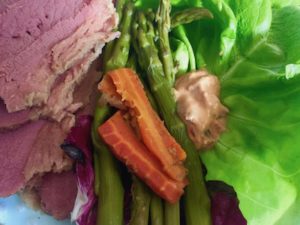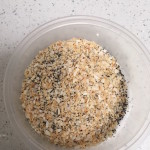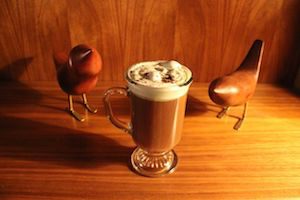Celebrating St. Patrick’s Day at Home
 (Gerry Furth-Sides, Roberta R. Deen) St. Patrick’s Day everywhere is thought of as a joyous national celebration of all things Irish and green – and goes for food, drinks, and fashion to honor “the Emerald Isle.” Corned beef and cabbage enjoy a special place on the table. So does soda bread. Both are proof that this holiday has come a long way from being a day of mourning for the patron saint of Erin into an Irish parade of rebellion against discrimination in American
(Gerry Furth-Sides, Roberta R. Deen) St. Patrick’s Day everywhere is thought of as a joyous national celebration of all things Irish and green – and goes for food, drinks, and fashion to honor “the Emerald Isle.” Corned beef and cabbage enjoy a special place on the table. So does soda bread. Both are proof that this holiday has come a long way from being a day of mourning for the patron saint of Erin into an Irish parade of rebellion against discrimination in American

Our corned beef (flat cut for less fat!), cabbage, spring asparagus and baby carrots cooked in a Sitram pressure cooker at home
Irish Soda Bread can even be prepared with Gluten-Free Flour. Here is Roberta Deen’s account from (//localfoodeater.com/easter-bread-chickpea-flour-cookbook/)

The flour (bread directions, photos courtesy of Roberta R. Deen)

The egg, honey, buttermilk flour blend whisked together(bread directions, photos courtesy of Roberta R. Deen)
 The “everything” bagel topping (bread directions, photos courtesy of Roberta R. Deen)
The “everything” bagel topping (bread directions, photos courtesy of Roberta R. Deen)

The resulting dough (bread directions, photos courtesy of Roberta R. Deen)

The filled muffin tin (bread directions, photos courtesy of Roberta R. Deen)

The finished soda bread on white Wedgwood (bread directions, photos courtesy of Roberta R. Deen)
We think any day is a good one to celebrate anything at The Raymond 1886. Duplicate the historic, cozy craftsman cottage in SouthPasadena to ring in the Irish holiday, with a holiday cocktail from Head Barman Peter Lloyd-Jones. The Tipperary, that you can craft with Tyrconnell Irish whiskey, Green Chartreuse, and Carpano Antica.

The Tipperary, (Courtesy of The Raymond 1886)
Birds & Bees, Bar Manager Bethany Ham createdThe Irish Grasshopper ($8) cocktail for the holiday. Ham’s take on the ubiquitous Irish Coffee by blending hot coffee with Jameson Black Barrel whiskey, sugar, Amaretto cream, and dark chocolate shavings to make the perfect cocktail.

Irish Grasshopper (Courtesy of Birds & Bees)
St. Patrick, born as Maewyn in Wales around 385 A.D., had a history of being kidnapped, enslaved and becoming a shepherd in Ireland before he was 20. Through it all, he developed a strong faith in God. After his escape and a long period of monastery study, he was ordained to the priesthood and returned to Ireland, where he was subsequently appointed as the second bishop.
St. Patrick not only converted thousands of Irish to Christianity, he founded hundreds of churches and known to have, “driven the snakes out of Ireland,” symbolizing the victory of the Christian faith over pagan rituals. Why the three-leaf lucky shamrock? Patrick explained the Holy Trinity doctrine to local tribesmen with it, the green color symbolizing renewal and the coming of spring after winter and the “pagan” darkness (much the same as the Christmas tree did at the winter solstice.
The downtrodden Irish population of Boston marched in the first St. Patrick’s Day on March 18, 1737, to make a statement about social status and job discrimination against them. Ireland’s very first Irish St. Patrick’s Day parade, in Dublin, took place in 1931.



 Gerry Furth-Sides
Gerry Furth-Sides  Barbara Hansen
Barbara Hansen  Chef-owner Alain Cohen
Chef-owner Alain Cohen  Roberta Deen
Roberta Deen  Jose Martinez
Jose Martinez  Nivedita Basu
Nivedita Basu